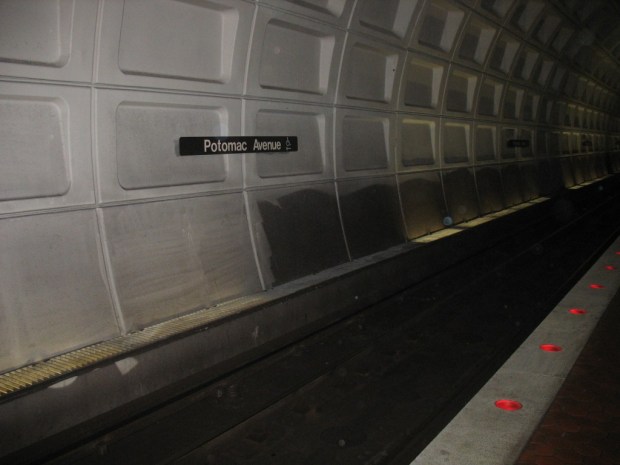Rail to Dulles: MWAA Board member Robert Brown suggests eliminating the Dulles Airport rail station and replacing it with a people mover to connect to the Route 28 station as a means to save costs. Yonah Freemark finds the concept intriguing, offering some operational considerations that could make it work.
However, the notion that building an entirely new landside people mover system will save money is ludicrous (IAD’s AeroTrain just clocked in at $1.4 billion). Likewise, while the concept would be an interesting solution to connecting an existing airport to an existing rail link (such as between BWI and the BWI rail station), the fact that the rail line has not yet built is a perfect opportunity to ensure that the airport itself is ‘on the way,’ to borrow Jarrett Walker’s terminology.
Freemark notes that one benefit of this concept would be to reduce travel time to the core and/or Tysons, but several other concepts considered by Metro would probably provide more utility to larger areas of service.
Meanwhile, Dulles offers a connection to the world via it’s ‘accidental aerotropolis.’
iPhones and agglomerations: When I last touched on the Aerotropolis, I noted Aaron Renn’s observation that the book isn’t so much about airports and cities as it is about globalization. One such element is the extensive description of the extraordinary agglomeration of manufacturing infrastructure and firms in Shenzhen.
This weekend’s New York Times contains a lengthy article on why the iPhone and other similar devices are not manufactured in the United States. In his blog, Paul Krugman sums up that article in one word: agglomeration. Some key snippets from the article:
But by 2004, Apple had largely turned to foreign manufacturing. Guiding that decision was Apple’s operations expert, Timothy D. Cook, who replaced Mr. Jobs as chief executive last August, six weeks before Mr. Jobs’s death. Most other American electronics companies had already gone abroad, and Apple, which at the time was struggling, felt it had to grasp every advantage.
In part, Asia was attractive because the semiskilled workers there were cheaper. But that wasn’t driving Apple. For technology companies, the cost of labor is minimal compared with the expense of buying parts and managing supply chains that bring together components and services from hundreds of companies.
For Mr. Cook, the focus on Asia “came down to two things,” said one former high-ranking Apple executive. Factories in Asia “can scale up and down faster” and “Asian supply chains have surpassed what’s in the U.S.” The result is that “we can’t compete at this point,” the executive said.
Since we’re talking about iPhones and not cheap Christmas ornaments, the availability of materials and the skill of the labor is more important than the cost of that labor – all benefits of the large agglomeration of technology firms in Shenzhen.
For years, cellphone makers had avoided using glass because it required precision in cutting and grinding that was extremely difficult to achieve. Apple had already selected an American company, Corning Inc., to manufacture large panes of strengthened glass. But figuring out how to cut those panes into millions of iPhone screens required finding an empty cutting plant, hundreds of pieces of glass to use in experiments and an army of midlevel engineers. It would cost a fortune simply to prepare.
Then a bid for the work arrived from a Chinese factory.
When an Apple team visited, the Chinese plant’s owners were already constructing a new wing. “This is in case you give us the contract,” the manager said, according to a former Apple executive. The Chinese government had agreed to underwrite costs for numerous industries, and those subsidies had trickled down to the glass-cutting factory. It had a warehouse filled with glass samples available to Apple, free of charge. The owners made engineers available at almost no cost. They had built on-site dormitories so employees would be available 24 hours a day.
The Chinese plant got the job.
“The entire supply chain is in China now,” said another former high-ranking Apple executive. “You need a thousand rubber gaskets? That’s the factory next door. You need a million screws? That factory is a block away. You need that screw made a little bit different? It will take three hours.”
More thoughts on iPhones, agglomerations, and jobs from Matt Yglesias and Tyler Cowen.
Likewise, an interesting set of charts looking at market share for various computing platforms – starting from more traditional personal computers, but eventually adding in smartphones and tablets. While smartphones and tablets aren’t yet substitutes for a personal computer, they’re getting closer.
Station Domination: via Tyler Cowen, an interesting post from Matt Glassman on the cost of Metro station advertising and the linkages between national politics and the local transit system.
In need of a good decongestant: Housing Complex takes a look at slight optimism from COG staffers on de-congestion pricing, and makes note of a lengthy Washingtonian piece on the subject.

















